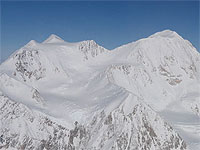|

...she was moving away down through the trees. I wanted to run after her and turn her around. I wanted to say clear beautiful things and I wanted her to say yes. But what could I have said? She was living with another man and had been for two years. I hadn't even noticed. I thought she was beautiful. That was all. She needn't have been more and couldn't have been less. He wouldn't marry her because he couldn't stand the idea of it. He was a would be socialist who threw cats down the stairs, or so she said. But then what could I have offered? I liked cats and thought socialism fine if to each need there accorded an ability to understand the need. But I couldn't tell her that and I couldn't think of anything else nor any good reason for going her way so I didn't. She was a pretty girl. She said she cut her hair today. I was sorry to have missed her: her hair to her waist, her gown to her knees, her feet bare on a frayed rag rug. She had a low wide warm orange bed and pictures on the wall and paintings and double shelves of books. I'd have taken all of her: books, paintings, pictures, and built a fire on an empty hill and placed her there white and alone and then wondered why. She was someone I loved and never knew; someone I only grew, out of a glance, a warm hello and parted teeth. Hungry and alone and would have burned her too but I didn't know who she was, and every time I struck a match she laughed...

Click to See the Real Letter...
Tragedy! Shortly after he declared his love to classmate Marcia van Gemert, 24-year old Walter Taylor (Walter Thrumble's real name) perished while climbing Mt. McKinley. At the time of his death he was in a combined medical/doctoral (M.D./ PhD) program at Indiana University's Indianapolis and Bloomington campuses. He graduated from West Lafayette High School, Indiana, in 1960 and graduated with a B.S. from Purdue University in 1964.
In Memoriam; Expedition Details
________
1967: Seven members of Joe Wilcox's twelve-man expedition perish, while stranded for ten days near the summit, in what has been described as the worst storm on record. Up to that time, this was the third worst disaster in mountaineering history in terms of lives lost.
Mount McKinley Tragedy
and Resulting Expedition.
 TWO expeditions, the Colorado Mount McKinley and the Wilcox McKinley expedltlons, joined to climb the Karsten's Ridge route. Seven members of the latter died high on the mountain. On July 18 Jerry Clark, Mark McLaughlin, Walter Taylor, Hank James, Dennis Luchterhand and John Russell radioed to Park Rangers from the summit; they had reached the top In a white-out after a bivouac the previous night. They were apparently caught during their descent by a violent and prolonged storm. A seventh member, Steve Taylor, had remained at their 17,900-foot camp, feeling slightly ill. He also perished, apparently after his tent was destroyed. Five other members, Joseph F. Wilcox, Anshel Schiff, Howard Snyder, Paul Schlichter and Jerry Lewis, had reached the summit on July 15 and had descended to a camp at 15,000 feet on the Harper Glacier to conserve food and fuel at the high camp. They were also struck by the storm, but escaped with exhaustion and minor frostbite. The Mountaineering Club of Alaska Expedition reached the 17,900-foot camp on July 28 and found a single victim there. They found two others just below the Archdeacon's Tower the following day. No identifications were made. TWO expeditions, the Colorado Mount McKinley and the Wilcox McKinley expedltlons, joined to climb the Karsten's Ridge route. Seven members of the latter died high on the mountain. On July 18 Jerry Clark, Mark McLaughlin, Walter Taylor, Hank James, Dennis Luchterhand and John Russell radioed to Park Rangers from the summit; they had reached the top In a white-out after a bivouac the previous night. They were apparently caught during their descent by a violent and prolonged storm. A seventh member, Steve Taylor, had remained at their 17,900-foot camp, feeling slightly ill. He also perished, apparently after his tent was destroyed. Five other members, Joseph F. Wilcox, Anshel Schiff, Howard Snyder, Paul Schlichter and Jerry Lewis, had reached the summit on July 15 and had descended to a camp at 15,000 feet on the Harper Glacier to conserve food and fuel at the high camp. They were also struck by the storm, but escaped with exhaustion and minor frostbite. The Mountaineering Club of Alaska Expedition reached the 17,900-foot camp on July 28 and found a single victim there. They found two others just below the Archdeacon's Tower the following day. No identifications were made.
To try to find and bury the bodies and learn how the tragedy occurred, Vin and Grace Hoeman, Ray Genet, Ed Boulton, Chuck Crenchaw and Dick Springgate were flown to the Kahiltna Glacier on August 19. Except for Mrs. Hoeman, they continued up the West Buttress, building snow caves for camps, the highest being at Denali Pass at 18,200 feet on the night of the 26th. Genet and Hoeman descended to near the 17,900-foot camp but found only a few inches of a bamboo pole above the snow, which had been eight feet above the surface a few weeks before. The camp was said to be 200 yards away, but probing was futile. On August 27 Hoeman, Genet, Crenchaw and Springgate headed for the top, which they reached in the afternoon. This was the latest ascent in the year yet made. Although they searched the slopes of the Archdeacon•s Tower carefully, no traces of the bodies were found.
...From The American Alpine Journal, Date Unknown, pg. 118
|